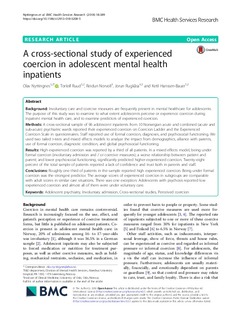A cross-sectional study of experienced coercion in adolescent mental health inpatients
Journal article, Peer reviewed
Published version

View/
Date
2018Metadata
Show full item recordCollections
Abstract
Background
Involuntary care and coercive measures are frequently present in mental healthcare for adolescents. The purpose of this study was to examine to what extent adolescents perceive or experience coercion during inpatient mental health care, and to examine predictors of experienced coercion.
Methods
A cross-sectional sample of 96 adolescent inpatients from 10 Norwegian acute and combined (acute and sub-acute) psychiatric wards reported their experienced coercion on Coercion Ladder and the Experienced Coercion Scale in questionnaires. Staff reported use of formal coercion, diagnoses, and psychosocial functioning. We used two tailed t-tests and mixed effects models to analyze the impact from demographics, alliance with parents, use of formal coercion, diagnostic condition, and global psychosocial functioning.
Results
High experienced coercion was reported by a third of all patients. In a mixed effects model, being under formal coercion (involuntary admission and / or coercive measures); a worse relationship between patient and parent; and lower psychosocial functioning, significantly predicted higher experienced coercion. Twenty-eight percent of the total sample of patients reported a lack of confidence and trust both in parents and staff.
Conclusions
Roughly one third of patients in the sample reported high experienced coercion. Being under formal coercion was the strongest predictor. The average scores of experienced coercion in subgroups are comparable with adult scores in similar care situations. There was one exception: Adolescents with psychosis reported low experienced coercion and almost all of them were under voluntary care.
Description
This article is distributed under the terms of the Creative Commons Attribution 4.0 International License, which permits unrestricted use, distribution, and reproduction in any medium, provided you give appropriate credit to the original author(s) and the source, provide a link to the Creative Commons license, and indicate if changes were made.
